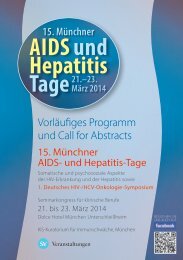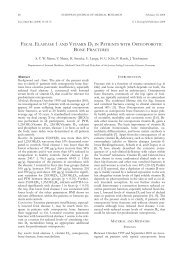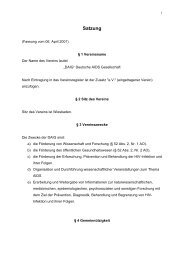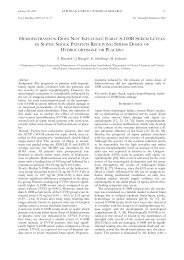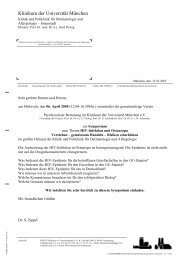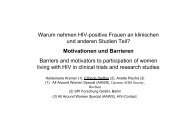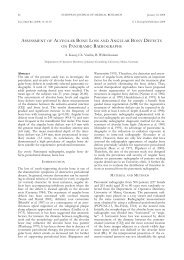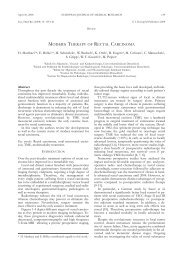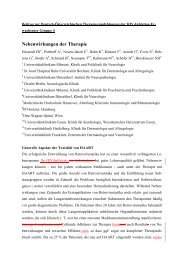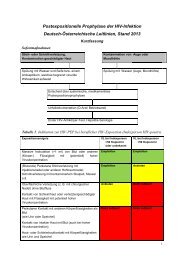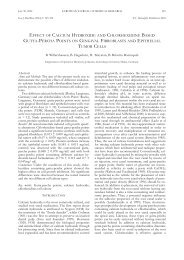European Journal of Medical Research - Deutsche AIDS ...
European Journal of Medical Research - Deutsche AIDS ...
European Journal of Medical Research - Deutsche AIDS ...
You also want an ePaper? Increase the reach of your titles
YUMPU automatically turns print PDFs into web optimized ePapers that Google loves.
June 27, 2007 EUROPEAN JOURNAL OF MEDICAL RESEARCH<br />
89<br />
D.26 (Poster)<br />
Efficacy <strong>of</strong> efavirenz-based HAART after<br />
switching from a protease inhibitor<br />
Khaykin P. 1 , Brenda D. 1 , Carlebach A. 2 , Knecht G. 3 ,<br />
Müller A. 1 , Stürmer M. 4 , Staszewski S. 1<br />
1 Klinikum der J.W.Goethe Unversität Frankfurt, HIVCEN-<br />
TER, Frankfurt, Germany, 2 Private Practice Friedenstrasse,<br />
Frankfurt, Germany, 3 Private Practice IFS, Frankfurt,<br />
Germany, 4 Klinikum der J.W.Goethe Unversität Frankfurt,<br />
Department <strong>of</strong> Virology, Frankfurt, Germany<br />
Objective: The aim <strong>of</strong> this database analysis was to investigate<br />
the efficacy and safety <strong>of</strong> efavirenz (EFV)-based<br />
HAART after switching from protease inhibitor (PI)-based<br />
regimens.<br />
Methods: Data were analyzed from 50 HIV+ patients who<br />
were taking two or three NRTIs and one PI or boosted PI<br />
(PI/r) and then switched the PI to EFV. The reasons for<br />
switching were side effects, virologic failure, and non-compliance.<br />
Summary <strong>of</strong> results: 22/50 patients were still on the EFV at<br />
the time <strong>of</strong> analysis. Viral load in the OT analysis decreased<br />
from 4.9 log10 to 1.6 log10 copies/ml. Of the patients who<br />
discontinued EFV, reasons given were virologic failure in<br />
20%, adverse events in 22% and non-compliance in 14% <strong>of</strong><br />
the patients. Patients who showed virologic failure had prior<br />
experience with different therapy regimens or showed 2 or 3class<br />
resistance. Among the patients who stopped EFV therapy<br />
due to adverse events, CNS side effects were the most<br />
common.<br />
Conclusions: Modification <strong>of</strong> a HAART regimen may lead to<br />
viral suppression if EFV is substituted for a PI or PI/r. However,<br />
some patients in our study demonstrated adverse events<br />
or virologic failure. Most <strong>of</strong> the patients who discontinued<br />
EFV had 2- or 3-class resistance in their treatment history.<br />
D.27 (Poster)<br />
Darunavir (TMC114) in highly pre-treated<br />
HIV-1-infected patients: Clinical experience<br />
obtained from routine clinical practice<br />
Schmied B. 1 , Cichon P. 1 , Egle A. 2 , Geit M. 3 ,<br />
Gmeinhart B. 4 , Haas B. 5 , Kanatschnigg M. 6 , Kapper A. 5 ,<br />
Rieger A. 4 , Sarcletti M. 7 , Schlag M. 8 , Taylor N. 2 ,<br />
Zangerle R. 7<br />
1 Otto Wagner Hospital, II. <strong>Medical</strong> Department Pulmological<br />
Centre SMZ Baumgartner Höhe, Vienna, Austria,<br />
2 III. <strong>Medical</strong> Department University <strong>of</strong> Salzburg, Division <strong>of</strong><br />
Hematology , Oncology and Infectious Diseases, Salzburg,<br />
Austria, 3 General Hospital <strong>of</strong> Linz, Department <strong>of</strong><br />
Dermatology and Venerology, Linz, Austria, 4 University <strong>of</strong><br />
Vienna <strong>Medical</strong> School, Department <strong>of</strong> Dermatology, Division<br />
<strong>of</strong> Immunology, Allergy and Infectious Diseases, Vienna,<br />
Austria, 5 General Hospital – Graz West, I. <strong>Medical</strong><br />
Department, Graz, Austria, 6 General Hospital Klagenfurt, I.<br />
<strong>Medical</strong> Department, Klagenfurt, Austria, 7 University <strong>of</strong><br />
Innsbruck, Department <strong>of</strong> Dermatology and Venereology,<br />
Innsbruck, Austria, 8 Janssen-Cilag Pharma GmbH, Vienna,<br />
Austria<br />
Background: The activity <strong>of</strong> boosted Darunavir (DRV/r,<br />
600/100 mg bid), a novel protease inhibitor (PI), against PIresistent<br />
virus has been proven in clinical trials. A Named Patient<br />
Program allowed to assess treatment results obtained in<br />
routine care settings.<br />
Objective: To evaluate the safety and efficacy <strong>of</strong> DRV/r containing<br />
ART when used in routine clinical practice and factors<br />
influencing outcomes.<br />
Methods: 31 HIV-1-infected patients were included. Patients<br />
were at least 3-class-experienced. All were naïve to DRV.<br />
Median baseline CD4 cell count: 160 (2-914), median HIVviral<br />
load: 3,99Log10 (1,69-6,18), 5 subjects had viral load<br />
(VL) < 50 c/ml. Patients were followed up according to local<br />
standard <strong>of</strong> care. Genotypes were used to determine DRVspecific<br />
resistance-associated mutations (DRV-RAMs) and<br />
genotypic sensitivity scores (GSS) for the optimized backbone<br />
regimen (OBR).<br />
Results: At cut-<strong>of</strong>f (Feb 07), treatment with DRV/r was initiated<br />
in 28 patients. The OBR contained 2 or 3 NRTIs.<br />
TMC125 was added in 4 patients. Ten subjects (36%) used<br />
Enfuvirtide (ENF), there<strong>of</strong> 7 (25%) naïvely. Median followup<br />
time: 25 weeks (range 4-84). 16/23 subjects (70%) reached<br />
VL2<br />
DRV-RAMs, respectively. Response at week 12 was decreased<br />
in patients with a GSS <strong>of</strong> £ 0,5 (less than 1 fully active<br />
drug in OBR) and in the presence <strong>of</strong> > 2 DRV-RAMs.<br />
There was no difference in response <strong>of</strong> ENF-users (ENFnaïve)<br />
as compared to ENF non-users, however, in patients<br />
using ENF naïvely, ENF represented the only fully active<br />
drug in the OBR.<br />
Conclusions: DRV-based cART showed very good safety<br />
and efficacy in a group <strong>of</strong> highly pre-treated patients in routine<br />
care settings. Careful consideration <strong>of</strong> treatment history,<br />
DRV-RAMs and GSS can help to design the optimal DRVbased<br />
cART. Further follow up <strong>of</strong> efficacy and safety is needed<br />
to prove long-term outcomes.<br />
D.28 (Vortrag)<br />
Transfer <strong>of</strong> autologous gene-modified T lymphocytes<br />
in HIV-infected patients with advanced<br />
immunodeficiency and multidrug resistant virus<br />
von Laer D. 1 , von Lunzen J. 2 , M87o study group<br />
1 Georg-Speyer-Haus, Frankfurt am Main, Germany,<br />
2 Universitätskrankenhaus Eppendorf, Infektiologie, Hamburg,<br />
Germany<br />
Aims: Drug toxicity and viral resistance limit long-term efficacy<br />
<strong>of</strong> antiviral drug treatment for HIV infection. Thus, alternative<br />
therapies need to be explored.<br />
Methods: Here, we tested the infusion <strong>of</strong> T lymphocytes<br />
transduced with a retroviral vector (M87o) that expresses an<br />
HIV entry inhibitory peptide (maC46). Gene-modified autologous<br />
T cells were infused into 10 HIV-infected patients with<br />
advanced disease and multidrug resistant virus during antiretroviral<br />
combination therapy.<br />
Results: T cell infusions were tolerated well with no severe<br />
side effects. A significant increase <strong>of</strong> CD4 counts was observed<br />
post infusion. At the end <strong>of</strong> the one-year follow-up, the<br />
CD4 counts <strong>of</strong> all patients were still around or above baseline.<br />
Gene-modified cells could be detected in peripheral blood,<br />
lymph nodes and bone marrow throughout the one-year fol-



